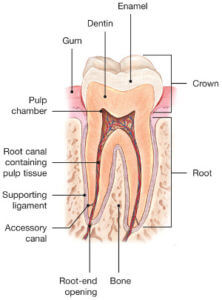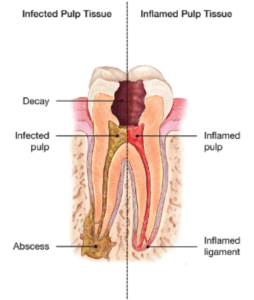Endodontic FAQ
What is endodontic treatment?

In literal terms, Endodontic treatment means treatment of the inner part of the tooth. In Greek, Endo means “inside” and “odont” means “tooth.” The anatomy of the tooth consists of the crown and the root. The crown is the part of the tooth seen in the oral cavity above the gum line. The root is the part of the tooth invisible to the naked eye in the oral cavity and located below the gumline.
The tooth also functions as an organ consisting of three layers from the outer to the innermost part of the tooth: enamel, dentin, and pulp. The pulp which is located in the innermost part of the tooth known as the pulp/canal space plays a critical role in the growth and development of a tooth.
What is a root canal treatment?
 It is the treatment of the innermost part of the tooth known as the pulp in the canal space located in the root aspect of the tooth.
It is the treatment of the innermost part of the tooth known as the pulp in the canal space located in the root aspect of the tooth.
Root canal treatment may be necessary when the pulp in the root canal becomes inflamed or infected. The inflammation or infection can occur as a result of: tooth decay, defective tooth filling, trauma to the tooth, presence of crack/fracture in the tooth, etc.
If pulp inflammation or infection is left untreated, it can cause pain or lead to an abscess.
Are root canals painful?
Many endodontic procedures are performed to relieve the pain of toothaches caused by pulp inflammation or infection. The pain from a toothache can be relieved when an endodontist removes the damaged tissue through root canal treatment. Endodontists use specialized techniques to ensure patients are thoroughly comfortable during their treatments. We are experts in administering numbing medications, especially in patients who traditionally have problems getting and staying numb. In addition to treating you comfortably, patients will be relieved of tooth pain after their treatment when the pulp infection or inflammation heals.
With modern techniques and anesthetics, most patients report that they are comfortable during the procedure.
Are root canals safe?
As Endodontists, we have materials and equipment designed to make your treatment more successful, comfortable, and, most importantly, safe! We use a small sheet of latex called a dental dam to isolate the tooth during treatment, protecting the rest of your mouth. Digital radiographs and 3-D imaging allows us to take detailed pictures of tiny tooth anatomy to better see the root canals and any related infections. We also use dental operating microscopes to better see inside the root canals to thoroughly treat them.
